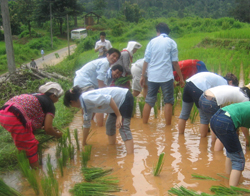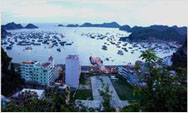You are here » Home » Telling Our Story
Case Study
Tourism operators join forces to attract visitors and cash
City Sets its Sights on Tourism

| |
Photo: KIAsia/Paul Wedel
|
|
A promotional event introduces the concept of “edutainment” tourism where visitors learn about rice planting practices among hill tribes near Chiang Mai.
“We anticipate that the local street guide and shopping directory will generate an additional $452,000 in profits to local businesses and improved collaboration among members,” said USAID partner and KIAsia Executive Director Paul Wedel.
|
Challenge
The exotic natural beauty of Thailand’s beaches and forests, the sophisticated palate, and the generous hospitality of the Thai people attract over ten million tourists to Thailand annually. The tourism industry is critical to the country’s economy — it generates employment, small business opportunities, and a great deal of revenue. Unfortunately for industry operators in the northern city of Chiang Mai, tourists there spend an average of only $67 per day — 27 percent below the national average.
Initiative
To help Chiang Mai generate more income from tourism, USAID supported a program to sharpen its competitive edge. The goal was to capture a greater share of the country’s $7 billion annual tourism revenue. Chiang Mai created a tourism industry “cluster” representing 85 businesses, two universities, the National Tourism Agency, and the city government. A cluster is a group of industry-specific companies in a geographic area that collaborate to increase their own productivity and growth. The cluster created a private destination management company to oversee initiatives to spur tourism development. USAID sponsored a niche marketing campaign to bring high-spending tourists to golf, spa, and eco-tourism destinations in Chiang Mai.
Results
Members of the cluster funded a market study and held workshops to stimulate interest in Chiang Mai. Through meetings, conventions, and exhibitions, the cluster began spreading the word about the city’s tourist appeal. Companies in the cluster also contributed to the industry’s growth through private investment. One member, Track of the Tiger Tour Group, invested $67,500 in a street directory to help tourists locate the out-of-the way shops and neighborhoods. The local government earmarked $75,000 for English language training for workers in the tourism sector. By collaborating to realize their strategic objectives, the businesses leaders of Chiang Mai are transforming the city’s landscape and boosting its revenues.
Print-friendly version of this page (532kb - PDF)
Click here for high-res photo
Back to Top ^ | 

